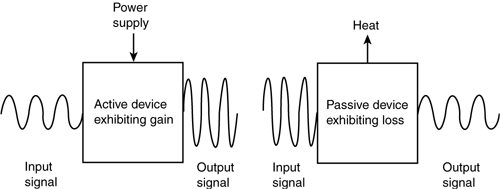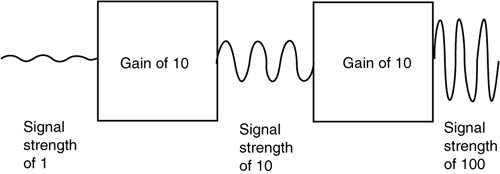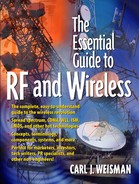LOSS AND GAIN
Devices
While an electrical signal is in the form of a current inside a transmitter or receiver, cruising around on some conductor, it encounters many different objects called components or devices. There are literally hundreds of different components which exist for some reason or another, but all components fall into one of two categories: active or passive. The difference is very simple. If it requires a power supply for it to work properly, it is an active component, otherwise, it is passive.
All components (active and passive) exhibit one of two properties: loss or gain. If the signal coming out is bigger than the signal going in, the device exhibits gain. If the device exhibits gain, it is called an amplifier. All amplifiers are active devices (i.e., they require a power supply). If you don't believe me, take the battery out of a cellular phone and try to make a call. In a cellular phone, the battery is connected to several amplifiers (among other things).
Attenuation
If the signal coming out is smaller than the signal going in, then the device exhibits loss. Any signal which passes through a device exhibiting loss is said to experience attenuation or is attenuated.
There are many different devices which exhibit loss; some are active and some are passive. You may be wondering (or maybe not), if a big RF signal goes in and a little RF signal comes out, what happens to the rest of the signal, the part that does not come out? It gets converted to heat. Components that exhibit loss warm up, components that exhibit a lot of loss get hot, and components that exhibit too much loss melt, which is why the power handling capability of passive devices is very important.
Figure 2-1 is a visual summary of gain and loss. The signal on the left experiences gain as it goes through the active device, as can be seen by the signal (represented by the sine wave) getting bigger. If the signal gets bigger, what must the device be? Here's a hint, it starts with "a" and ends with "mplifier." The signal on the right experiences loss, as the output signal is smaller than the input signal. If the signal gets smaller, what must the device be? This is a trick question, as it can be any one of a myriad of things, which will be discussed shortly.
Figure 2-1. Devices exhibiting gain and loss.

If a signal coming out of an amplifier is ten times bigger than the signal going in, the amplifier has a gain of ten. If there are two of these amplifiers in a row, the resulting gain of both amplifiers is 100 (not 20!). If a signal is made ten times bigger and then that signal is made ten times bigger still, the final signal is 100 times bigger than the signal going into the first amplifier. It is simple multiplication (see Figure 2-2).
Figure 2-2. The result of multiple gain stages.

Insertion Loss
Passive devices exhibit the exact opposite behavior of active devices. If the signal coming out of a passive device is 1/100th as big as the signal going in, then that device has a loss of 100 and the input signal is divided by 100 to find the magnitude of the output signal. If a signal has a strength of 100 watts and experiences a loss of 100, the output signal will be one watt. The loss a signal experiences as it goes through a passive component is referred to by RF engineers as insertion loss (IL). (Apparently, the word loss by itself just isn't descriptive enough.)
Did You Know?
Because of their heat dissipating property, most passive RF components are now rated with something called thermal impedance. The thermal impedance of a device is simply a measure of how hot it gets, given a certain amount of input power. The unit of measure for thermal impedance is degrees Celsius per watt.
